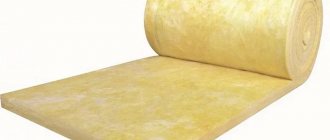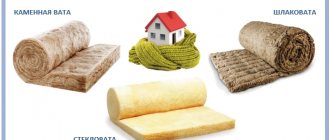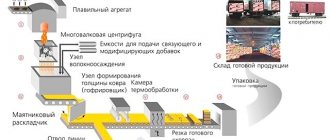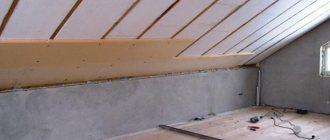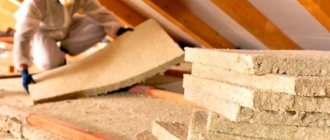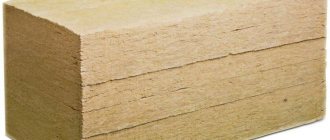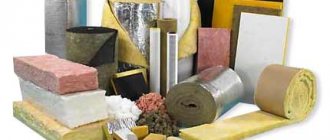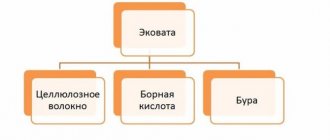Is it time to insulate your home? But there is no solution to the question of which insulation to give preference? Yes, you need to make the right choice, and it doesn’t matter what size you have, whether you are a private owner or a large developer! Let's figure out which mineral wool is better for insulation, and why basalt heat insulation is recognized by more than 70% of consumers around the world. All the facts in numbers!
Types of mineral wool and their differences
Mineral wool has a fibrous structure of various orientations, which can be:
- horizontal;
- vertical;
- corrugated (wavy);
- combined (mixed).
Thanks to the thin cross-section of the fibers and the air mass, it is light and convenient for transportation and installation. The small diameter of each thread helps slow down heat transfer, so behind a small layer of 50-100 mm it will be warmer than behind brickwork of the same width. The range of application of the material starts from insulation of walls, floors and ceilings, to insulation of lines with liquid carriers, industrial containers.
Among the well-known manufacturers of mineral wool are:
Rockwool.
Knauf.
Izovol.
Isover.
Paroc.
Ursa.
In addition to mineral wool, popular names include “basalt”, “stone”, “slag” and “glass wool”. Some buyers, trying to figure out which is better - stone wool or mineral wool, turn to sellers at the market or in the supermarket with similar questions, and inevitably bring a smile to their face.
It’s worth clarifying here: mineral wool refers to all materials that have a similar fibrous structure and are used for sound and heat insulation. That is, stone or basalt, as well as glass wool - these are all types of mineral wool. It makes no sense to talk about the advantages of mineral wool, since this is the general name for a group of fleecy insulation materials. Let's look at what they are separately and what are the features of each of them.
The materials used for insulation of vertical and horizontal surfaces, as well as sound insulation, are prescribed in GOST 52953-2008. They are divided into three types: glass wool, stone wool and slag wool. The latter is made from molten slag, which is a by-product of blast furnaces. Due to its weak structure and high tendency to absorb moisture, it is not very suitable for insulating rooms and will not be considered in this comparison.
Glass wool (glass wool)
The production of glass wool is similar to the production of glass. For the base, sand, borax, limestone and soda are taken. Broken glass can be used, which is the use of recycled materials and provides even greater savings in the cost of the process.
The substances are mixed and fed into the hopper. The composition is heated to a temperature of 1400 degrees, due to which it melts, turning into glass. But they don’t let him freeze. The liquid hot substance is passed through dies into a special centrifuge. Due to the high centrifugal force and the action of steam, the material is divided into multiple thin glass threads.
In order for the fibers to better hold together, polymer substances are added to the composition, acting as binders. Often these are formaldehyde resins, the amount of which can reach 4% of the total mass. In the glass wool of recent years of production, there are new developments where a petroleum composition is used, which has increased the strength of the final product.
The combined mass is dried at a temperature of 250C, which consolidates the polymerization. During this process, the fibers harden and become yellowish in color. After final cooling, it is cut and packaged for sale. The product can be supplied in slabs or rolls of different thickness and density, which is important to pay attention to when choosing.
The thickness of the resulting fibers can vary from 5 to 15 microns, and the length of the threads from 15 to 50 microns. When thousands of similar fibers are woven together, this gives sufficient strength and does not allow the material to fall apart. But individually, each thread is fragile, so it is easily damaged by impacts. The consequence of this is itching and irritation on the skin when invisible fragments dig into bare areas of the body.
Glass wool in a roll.
Basalt (stone) wool
To produce basalt insulating slabs, rock (most often of volcanic origin, frozen on the surface) is used. Hence the second name stone wool. The raw materials are melted in furnaces to a temperature of 1500 degrees and fed into a centrifuge. Rotation at high speed helps separate thin threads from the total mass.
The resulting fibers are immediately subject to the addition of binders (the same formaldehyde resins and petroleum compounds). Under high air pressure, the materials are pushed into the chamber, where it cools and compacts, forming a fleecy substance. Using mechanical cutting, it is given shape and size.
Basalt wool in slabs.
Basalt wool is produced in the form of rolls or slabs. The thickness of an individual fiber is 3-5 microns, and the length does not exceed 16 mm. Therefore, the material has low thermal conductivity and is more durable. Due to the production from stone, the threads are not so brittle and do not dig into open areas of the body.
Having obtained a general idea of the methods for producing types of insulation, you can move on to the details. To find out which is better - stone wool or glass wool, we will consider the key characteristics of each material and highlight the leader by position.
What is better to insulate with polystyrene foam?
This material has proven itself very well in places where air humidity is quite high but insulation is required.
- Foam plastic will not do anything when in contact with wet ground, so it can perfectly insulate foundations, as well as various engineering structures located underground. Tens of years will pass, and the insulation will remain the same as at the very beginning. It is often used in the construction of multi-layer foundations as a middle layer. It turns out to be a very reliable and high-quality foundation.
- When building houses without basements, on a monolithic foundation, it is also convenient to use polystyrene foam. Plates of this material are laid on a leveled area, and then a layer of concrete is poured on top of them. The slabs themselves can be either one row or several. After the concrete has hardened, the walls of the house begin to be erected.
- To prevent the foundation of the house from freezing, it is very effective to insulate not only its vertical, but also its horizontal part with polystyrene foam. Expanded polystyrene slabs are laid along the foundation. Then they are backfilled, if necessary, additionally laying a waterproofing layer. This method of insulation reliably protects the foundation from frost.
- The walls of houses (both inside and outside) can also be effectively insulated with polystyrene foam. It is best if these walls are block or brick. A high thermal insulation effect is achieved when using polystyrene foam to insulate interior spaces, and the formation of a dew point is not observed.
- For non-ventilated roofs (warm, flat roofs), the PSBS grade of expanded polystyrene is used. A waterproofing layer must be placed on top. For cold roofs that are ventilated, thermal insulation is carried out differently. The inside of the roof is insulated with polystyrene foam, leaving space for ventilation. This prevents water vapor from condensing.
- It is also good to insulate floors and ceilings between floors with foam boards. A layer of insulating material is placed under them, and concrete is poured on top.
- A variety of packaging is also made from polystyrene foam, and it is also used for thermal insulation of refrigerators, freezers and special isothermal vans.
Thermal conductivity
Thermal conductivity is the ability of a material to transfer thermal energy from a warm part of the material to a colder part. When it comes to insulating walls or floors, the lower the indicator, the longer the external cold will not be able to penetrate the room, and therefore heating costs will be reduced. In the summer heat, thermal conductivity has the opposite effect and helps keep the inside of the house cool.
Due to its fibrous structure, heat transfer through mineral wool depends on the thickness of the threads. Glass wool with fibers of 5-15 microns has a thermal conductivity index of 0.038-0.046 W/(m*K). And basalt wool, with fibers with a cross-section of 3-5 microns, begins its minimum value from 0.033 W/(m*K). Since insulation made from a basalt base has thinner threads, heat transfer through them takes longer, which makes it a leader in this characteristic.
Reviews about mineral wool
Andrey, 35 years old, Murmansk: “I tried a lot of insulation materials in my work. For insulation of bathhouses and houses made of timber, I give preference to stone mineral wool, since it is easier to work with and has a longer service life.” Igor, 45 years old, Sevastopol: “I consider stone mineral wool to be the best insulation at an affordable price. However, if the customer has enough money, I recommend using ecowool - a completely natural insulation material that has a longer service life.”
Density and mass of materials
Density affects the mass of a material. The denser the slab, the more weight it will have on the insulated structures. Glass wool has a density from 11 to 200 kg/m3. Stone wool is produced with a density of 15-220 kg/m3.
With the same roll sizes, stone wool is denser and is clearly in the lead, but this victory has a second side - weight. In the case of a ceiling, second floor floor or walls, basalt slabs will exert greater pressure on the structures underneath, which must be taken into account at the design stage.
Transportation
*
When choosing a thermal insulation material, it is worth taking into account such an obligatory factor as transportation. There is a big difference between mineral wool and glass wool. Glass wool will be more convenient during transportation, because it is lighter, the rolls are compressed into more convenient rolls or equally convenient slabs, which will make unloading easier. During transportation, it does not lose its qualities and shape, because it is more resistant to vibrations. And transportation of mineral wool will be less convenient due to larger rolls and greater weight, which will complicate loading and unloading of the material. If you are not careful when loading, unloading and transporting, there is a possibility of damaging the mineral wool. Or there is simply the possibility that the mineral wool will lose its shape during transportation.
Glass wool
Water absorption
If there is a possibility that the structure in which the insulation is embedded may come into contact with water, then the water absorption indicator is important, indicating how quickly the insulating layer will get wet. When wet, its properties deteriorate significantly, so when choosing insulation for entrance doors or filling walls in a bathhouse, you should give this priority attention.
The water absorption of glass wool is 1.7% by weight after 24 hours of direct contact with water. Basalt slabs have a value of 0.095%, making it twice as good in this category.
Is it possible to unlock the lock with your own hands if there is no key?
If you are left without a key and urgently need to open the door, then there is no need to panic.
Try to evaluate the problem that has arisen. After all, when the entrance is blocked by a flimsy interior door, it can often be unlocked without any special skill. But if you have to deal with a metal entrance door from a well-known manufacturer, then even a specialist will have to work hard. If you are not confident of success, then you should not waste time and effort and damage the door structure with improvised tools. In such situations, it is recommended to entrust this work to professionals. If a specialist takes on the job, he will be able to open a lock of any design. He is familiar with the features of many locking mechanisms, so it will not be difficult for him to unlock the door in an intelligent way, keeping the locking mechanism intact. Therefore, deciding to use the services of a specialist will not always be a wise decision. The reliability of some models may be imaginary. and therefore, if you have the necessary tools, you can open them quickly enough. We will talk about the most accessible of them further.
Operating and maximum temperature range
This parameter affects the location of operation, especially if the insulation will be installed on the roof or next to a heat source (boiler, heating radiators). Glass wool has a temperature range of -60 to + 450 °C. Stone wool will withstand even greater temperatures from -180 to + 750 degrees. Here, stone wool is definitely superior to its counterpart.
Shrinkability
Shrinkage involves sliding or caking of the insulation after some time. If the tendency of the material to shrink is high, then voids without insulation may form and the thermal insulation of the building will deteriorate.
Here, the difference between basalt wool and mineral fiberglass wool lies in the improved structure of the first. Some of the basalt wool fibers are located vertically, which prevents caking throughout its entire service life. The same cannot be said about glass wool, which, if properly installed, can last for a long period, but will still shrink over time. Glass wool placed in horizontal structures is subject to shrinkage the most, where, in addition to caking, sliding of the material can occur.
Ease of installation
Both materials cut equally well. The degree of compression allows them to be conveniently placed between rafters or posts, even if cut to a slightly larger size. But glass wool is highly prickly due to the vitreous fibers, which injures the skin. Even with protective gloves, it penetrates between the threads of the fabric and causes harm.
Stone wool is softer and does not leave itching, but it creates more dust in the air (the fibers are thinner and lighter). But since you need to work with both types in a respirator, due to its less causticity, the stone one is clearly more convenient.
What to do if you are injured by fiberglass
Specific disadvantages of glass wool thermal insulation boil down to the high degree of fragility of the fiber. This leads to the formation of extremely thin and sharp chips that penetrate the human skin, causing it to itch. Glass wool particles from the insulating layer can penetrate clothing, after which they are almost impossible to remove. Specialists working with fiberglass insulation wear tight overalls, do not allow the formation of open skin, and need a respirator, safety glasses and gloves. It is very dangerous for fiberglass particles to get into the eyes and lungs; this will cause inevitable irritation of the organs.
There are first aid rules for unsuccessful handling of fiberglass insulation:
When glass wool comes into contact with the skin, itchy areas should not be scratched; The particles are very carefully shaken off the hair, then the eyes are closed and the head is lowered into a bath or large container without water, shaken off with a movement of the neck; taking a cold shower without any detergents or washcloths under strong water pressure is the next step; hot water expands pores, so it is not used;
if a fiberglass irritant gets into your eyes, they should be rinsed with a stream of cold water, after which you must consult an ophthalmologist, perhaps even call an ambulance or go to an eye surgery if you feel unwell; if a person has inhaled glass wool fragments and experiences symptoms of difficulty breathing and coughing, they should definitely see a doctor;
contaminated clothing is thrown away, since even repeated washing will not completely remove glass wool fragments.
Summary table comparing stone wool and glass wool
| Basalt (stone) wool | Glass wool (glass wool) | |||||||
| Thermal conductivity, W/(m*K) | 0,038-0,046 | 0,035 – 0,042 | ||||||
| Specific density, kg/m3 | 15 to 220 | 11-200 | ||||||
| Weight | heavier | easier | ||||||
| Vapor permeability, mg/(m.h.Pa) | 0,3 | 0,4-0,7 | ||||||
| Water absorption, % by weight for 24 hours | 0,095 | 1,7 | ||||||
| Operating and maximum temperature range, 0C | -180 to + 750 | -60 to + 450 | ||||||
| Shrinkability | not susceptible | susceptible | ||||||
| Ecological cleanliness | pure material | pure material | ||||||
| Flammability | non-flammable material, can withstand temperatures up to 750 0C | non-flammable material, can withstand temperatures up to 450 0C | ||||||
| Durability, years | 50 | 20-50 | ||||||
| Chemical resistance | high | average | ||||||
| Sound absorption coefficient | 0,75 — 0,95 | 0,8 — 0,92 | ||||||
| Installation | more convenient | less convenient | ||||||
| Price | higher | less | ||||||
